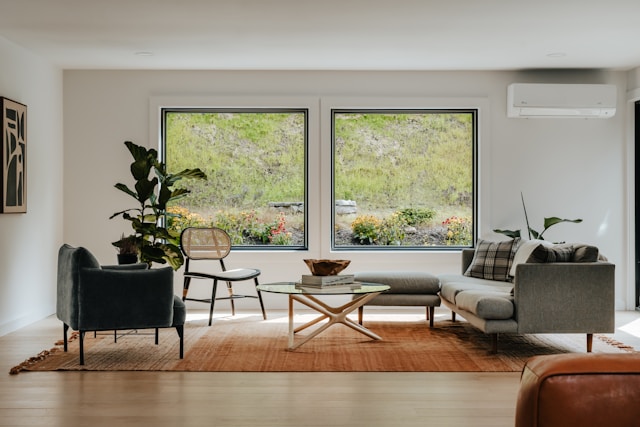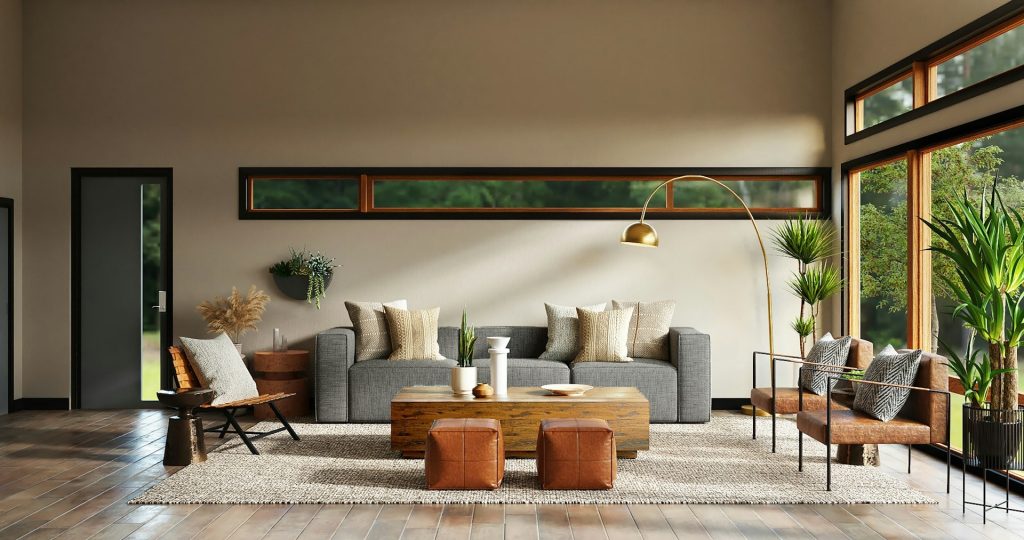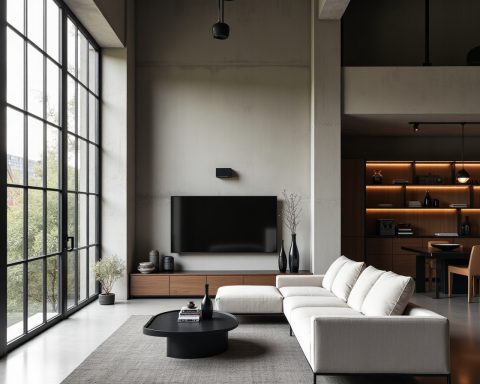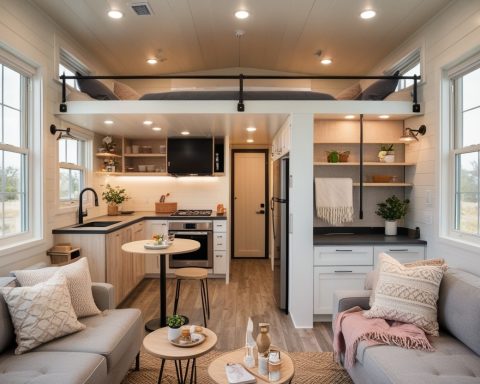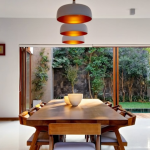Minimalist design is often misunderstood as a cold, stark aesthetic. However, when executed thoughtfully, it can create a serene and inviting sanctuary. The key is to balance simplicity with warmth, creating a space that is both visually appealing and emotionally comforting. This guide explores the essential elements of designing a minimalist home that feels cozy, focusing on intentional choices and harmonious balance.
1. The Foundation: Understanding Warm Minimalism
Before we dive into the specific design elements, it’s crucial to understand the philosophy behind warm minimalism. This approach acknowledges that minimalism isn’t about deprivation, but rather about creating a space that nurtures both the eye and the soul. It’s about intentionality, sensory richness, and personal connection.
- Intentional Simplicity: Every element serves a purpose, contributing to the overall harmony of the space.
- Sensory Richness: Textures, colors, and lighting are carefully chosen to evoke feelings of comfort and relaxation.
- Personal Connection: The space reflects the individual’s personality and values, creating a sense of belonging.
2. The Power of a Warm Color Palette: Evoking Comfort through Subtlety
Color has the power to transform a space, setting the mood and influencing emotions. In a minimalist home, a warm color palette is essential for creating a cozy atmosphere. We need to go beyond the stereotypical stark whites and grays.
- Soft Taupes and Beiges: These earthy tones provide a grounding effect, creating a sense of stability and warmth.
- Creamy Whites: Offer a softer, more inviting alternative to stark white, reflecting light without creating harsh shadows.
- Muted Earthy Hues: Terracotta, sage green, and warm grays add subtle pops of color, bringing a touch of nature indoors.
- Monochromatic Depth: Employing a single color palette with varying shades and tones adds visual interest without disrupting the minimalist aesthetic. This creates a sense of depth and sophistication.
3. The Art of Layering Textures: Adding Tactile Richness
Texture is often overlooked in minimalist design, but it’s a crucial element for creating a cozy atmosphere. By layering different textures, you can add depth and visual interest to a space, making it feel more inviting and lived-in.
- Wool and Linen: Soft wool throws draped over linen sofas create a cozy, inviting seating area.
- Plush Rugs and Hardwood: A thick, textured rug softens the hard lines of polished hardwood floors, adding warmth underfoot.
- Woven Storage: Baskets made from natural fibers like rattan or jute add both texture and functionality.
- Matte Wood Finishes: Natural wood furniture with a matte finish adds an organic touch, grounding the space.
4. Embracing Natural Elements: Connecting with the Outdoors
Bringing nature indoors is a fundamental principle of warm minimalism. Natural elements add a sense of tranquility and connection to the outdoors, creating a calming and grounding atmosphere.
- Organic Wood Furniture: Pieces with rounded edges and natural wood grains add a sense of organic flow.
- Stone and Ceramic Decor: Handcrafted pottery and stone sculptures bring a touch of earthy elegance.
- Indoor Plants: Plants like snake plants, ferns, and fiddle-leaf figs purify the air and add a vibrant touch of green.
- Natural Fiber Textiles: Cotton, linen, jute, and hemp add a sense of natural comfort and breathability.
5. The Importance of Soft Lighting: Creating a Warm Ambiance
Lighting plays a crucial role in setting the mood of a home. In a minimalist space, soft, warm lighting is essential for creating a cozy and inviting atmosphere.
- Warm LED Bulbs: These create a soft, inviting glow, mimicking natural sunlight.
- Fabric-Shaded Lamps: Floor and table lamps with fabric shades diffuse light, creating a warm ambiance.
- String Lights: These add a whimsical touch, creating a cozy atmosphere in the evening.
- Candles: The flickering light of candles adds a touch of romance and intimacy.
- Dimmer Switches: Provide flexibility, allowing you to adjust the lighting to suit your mood and the time of day.
6. Comfortable and Functional Furniture: Prioritizing Comfort and Purpose
Minimalist furniture should not only be visually appealing but also comfortable and functional. Choosing pieces that serve multiple purposes can help to maximize space and create a clutter-free environment.
- Plush Sofas and Armchairs: Deep, comfortable seating invites relaxation.
- Layered Bedding: A well-made bed with high-quality linens and soft throws creates a cozy sanctuary.
- Multifunctional Pieces: Ottomans with hidden storage, extendable tables, and modular shelving maximize space and functionality.
7. Intentional Decor: Curating Meaningful Pieces
Minimalism isn’t about eliminating decor, but about curating pieces that hold meaning. By choosing a few well-selected items, you can add personality and visual interest to a space without cluttering it.
- Abstract Art: Soft, abstract designs add visual interest without overwhelming the space.
- Handcrafted Ceramics: Unique, handcrafted pieces add a touch of artistry and personality.
- Statement Mirrors: Mirrors reflect light and create a sense of spaciousness.
- Meaningful Mementos: Carefully selected personal items add a touch of history and sentimentality.
8. Smart Storage Solutions: Maintaining a Clutter-Free Environment
A clutter-free environment is essential for a cozy minimalist home. Investing in smart storage solutions can help to keep everyday items organized and out of sight.
- Built-in Shelving: Maximizes vertical space and keeps items organized.
- Hidden Storage: Under-bed drawers, storage ottomans, and concealed cabinets keep clutter out of sight.
- Wall-Mounted Hooks: Provide easy access to coats, bags, and accessories.
- Minimalist Storage Boxes: Conceal everyday essentials while maintaining a clean aesthetic.
9. The Comfort of Textiles: Adding Softness and Warmth
Textiles add a layer of softness and warmth to minimalist spaces. By incorporating natural fibers and cozy textures, you can create a more inviting and comfortable atmosphere.
- Sheer Curtains: Allow natural light to filter through, creating a soft, airy feel.
- Linen and Cotton Bedding: Natural fibers provide comfort and breathability.
- Throw Blankets and Cushions: Add layers of warmth and texture to seating areas.
10. Creating Cozy Nooks: Designing Personal Retreats
Even in a minimalist home, dedicated cozy spaces are essential. Designing small, personal retreats can provide a sense of comfort and relaxation.
- Reading Corners: A comfortable chair, soft lighting, and a small bookshelf create a relaxing reading nook.
- Meditation Spaces: A floor cushion, calming decor, and soft lighting create a tranquil space for mindfulness.
- Window Seats: Pillows and throws create a cozy spot for relaxation and reflection.
11. Open Spaces and Airy Layouts: Enhancing Flow and Light
Minimalism thrives on open spaces, but to keep them cozy:
- Avoid overcrowding with unnecessary furniture
- Arrange furniture to encourage easy movement
- Use mirrors to enhance the sense of space
- Allow plenty of natural light to enter
12. Adding Personal Touches: Reflecting Your Unique Style
Minimalism doesn’t mean removing personality from your home. Incorporate:
- Family photos in sleek frames
- Use of signature scents
- Handwoven textiles that tell a story
- A select few souvenirs that bring good memories
13. Balancing Empty Space: Creating Harmony and Balance
Empty space is a key element of minimalist design, but too much emptiness can feel sterile. To maintain balance:
- Use rugs to define spaces within a room
- Arrange furniture to create intimate areas
- Use subtle patterns
14. High Quality Materials: Investing in Longevity and Refinement
Quality over quantity is the essence of minimalism. Instead of filling your home with cheap, mass-produced items, invest in:
- Solid wood furniture
- Handmade ceramics
- High thread count linens
15. Integrating Smart Technology Thoughtfully: Enhancing Convenience Without Clutter
In a modern minimalist home, technology can play a significant role in enhancing convenience and comfort. However, it’s essential to integrate smart technology thoughtfully, ensuring it complements the minimalist aesthetic rather than detracts from it.
- Concealed Wiring and Outlets: Keep wires and outlets hidden to maintain a clean, uncluttered look.
- Smart Lighting Systems: Integrate smart lighting systems that allow you to control the ambiance with ease.
- Minimalist Smart Home Devices: Choose devices with sleek, minimalist designs that blend seamlessly with your decor.
- Integrated Sound Systems: Opt for in-wall or ceiling speakers to minimize visible clutter.
16. Emphasizing Natural Light: Maximizing the Benefits of Sunlight
Natural light is a vital element in creating a warm and inviting minimalist home. It not only enhances the sense of space but also contributes to a sense of well-being.
- Large Windows and Skylights: Maximize natural light by incorporating large windows and skylights.
- Light-Colored Walls and Ceilings: Use light-colored paint to reflect and amplify natural light.
- Minimal Window Treatments: Opt for sheer curtains or blinds that allow natural light to filter through.
- Strategic Mirror Placement: Place mirrors strategically to reflect and distribute natural light throughout the space.
17. Creating a Sense of Flow: Designing for Seamless Movement
A minimalist home should feel open and airy, with a sense of seamless flow between spaces. This can be achieved by carefully considering the layout and furniture placement.
- Open Floor Plans: Design open floor plans that allow for easy movement between rooms.
- Minimalist Furniture Placement: Avoid overcrowding furniture and create clear pathways.
- Consistent Flooring: Use consistent flooring throughout the home to create a sense of continuity.
- Strategic Use of Area Rugs: Use area rugs to define spaces without creating visual barriers.
18. Designing for Sustainability: Embracing Eco-Friendly Practices
Minimalism and sustainability go hand in hand. By choosing eco-friendly materials and practices, you can create a home that is both beautiful and environmentally responsible.
- Sustainable Materials: Opt for sustainable materials like bamboo, reclaimed wood, and recycled glass.
- Energy-Efficient Appliances: Choose energy-efficient appliances to reduce your carbon footprint.
- Water-Saving Fixtures: Install water-saving fixtures to conserve water.
- Natural Ventilation: Design your home to maximize natural ventilation and minimize the need for air conditioning.
19. Incorporating Art and Sculpture: Adding Visual Interest and Depth
Minimalist spaces can benefit from the addition of carefully selected art and sculpture. These elements can add visual interest and depth without disrupting the overall aesthetic.
- Large-Scale Artwork: Opt for large-scale artwork that makes a statement.
- Sculptural Pieces: Incorporate sculptural pieces that add a touch of artistic flair.
- Neutral Color Palettes: Choose artwork and sculpture with neutral color palettes to complement the minimalist aesthetic.
- Strategic Placement: Place artwork and sculpture strategically to create focal points.
20. Designing for Flexibility: Creating Adaptable Spaces
A minimalist home should be adaptable to changing needs and lifestyles. Designing flexible spaces can help to maximize functionality and create a sense of openness.
- Multifunctional Furniture: Choose furniture that can serve multiple purposes.
- Modular Shelving and Storage: Incorporate modular shelving and storage systems that can be easily reconfigured.
- Open Concept Living Areas: Design open concept living areas that can be easily adapted for different activities.
- Sliding Doors and Partitions: Use sliding doors and partitions to create flexible divisions between spaces.
21. Sound and Acoustic Considerations: Creating a Peaceful Atmosphere
Acoustics are often overlooked in minimalist design, but they play a crucial role in creating a peaceful and comfortable atmosphere.
- Soft Furnishings: Incorporate soft furnishings like rugs, curtains, and upholstered furniture to absorb sound.
- Acoustic Panels: Install acoustic panels to reduce echo and reverberation.
- Soundproofing Materials: Use soundproofing materials in walls and ceilings to minimize noise transmission.
- Plants and Greenery: Plants and greenery can help to absorb sound and create a calming atmosphere.
22. Creating a Sense of Harmony: Balancing Opposing Elements
A well-designed minimalist home strikes a balance between opposing elements, creating a sense of harmony and equilibrium.
- Balancing Light and Shadow: Create a balance between light and shadow to add depth and dimension.
- Balancing Warm and Cool Tones: Incorporate both warm and cool tones to create a sense of balance.
- Balancing Smooth and Rough Textures: Combine smooth and rough textures to add visual interest.
- Balancing Open and Enclosed Spaces: Create a balance between open and enclosed spaces to provide both privacy and openness.
23. The Importance of Personalization: Making It Truly Your Own
While minimalism emphasizes simplicity, it doesn’t mean sacrificing personal style. Adding personal touches can make your home feel unique and reflective of your personality.
- Meaningful Collections: Display meaningful collections of objects that reflect your interests and passions.
- Handcrafted Items: Incorporate handcrafted items that add a touch of artistry and individuality.
- Family Heirlooms: Display family heirlooms that hold sentimental value.
- Travel Souvenirs: Showcase travel souvenirs that evoke fond memories.
24. The Power of Simplicity in Details: Finding Beauty in the Smallest Things
Minimalist design often focuses on the big picture, but it’s the small details that can truly elevate a space. Pay attention to the subtle nuances that contribute to the overall aesthetic.
- Clean Lines and Finishes: Emphasize clean lines and smooth finishes in hardware and fixtures.
- Minimalist Hardware: Choose minimalist hardware that complements the overall design.
- Seamless Transitions: Create seamless transitions between different materials and surfaces.
- Consistent Color Accents: Use consistent color accents to create a cohesive look.
25. Embracing Imperfection: Celebrating the Beauty of Wabi-Sabi
Wabi-sabi is a Japanese aesthetic that celebrates the beauty of imperfection. Incorporating elements of wabi-sabi can add a touch of authenticity and warmth to a minimalist home.
- Natural Materials: Use natural materials with imperfections and variations.
- Handcrafted Objects: Incorporate handcrafted objects that showcase the artisan’s touch.
- Patina and Age: Embrace the patina and age of materials and objects.
- Asymmetrical Arrangements: Create asymmetrical arrangements that feel organic and natural.
26. The Role of Negative Space: Creating Visual Breathing Room
Negative space is just as important as positive space in minimalist design. It creates visual breathing room and allows the eye to rest.
- Open Walls and Ceilings: Keep walls and ceilings relatively bare to create a sense of openness.
- Strategic Furniture Placement: Arrange furniture to create clear pathways and open spaces.
- Minimalist Decor: Avoid overcrowding decor and leave ample empty space.
- Symmetrical Balance: Use symmetrical balance to create a sense of calm and order.
27. Creating a Sensory Experience: Engaging All the Senses
A well-designed minimalist home should engage all the senses, creating a holistic and immersive experience.
- Tactile Textures: Incorporate tactile textures that invite touch.
- Aromatic Scents: Use essential oils or candles to create pleasant aromas.
- Soothing Sounds: Incorporate soothing sounds like water features or wind chimes.
- Visual Harmony: Create visual harmony through color, texture, and light.
28. Designing for Longevity: Creating a Timeless Aesthetic
Minimalism is about creating a timeless aesthetic that transcends trends. Choose design elements that will stand the test of time.
- Classic Furniture Pieces: Invest in classic furniture pieces that will never go out of style.
- Natural Materials: Use natural materials that age gracefully.
- Neutral Color Palettes: Choose neutral color palettes that are versatile and enduring.
- Simple Forms and Lines: Focus on simple forms and lines that are inherently timeless.
29. Cultivating a Sense of Calm: Creating a Sanctuary for the Soul
Ultimately, a minimalist home should be a sanctuary for the soul, a place where you can escape the chaos of the outside world and find peace and tranquility.
- Quiet Spaces: Create quiet spaces for meditation or reflection.
- Clutter-Free Environment: Maintain a clutter-free environment to promote a sense of calm.
- Natural Elements: Incorporate natural elements that evoke feelings of peace and serenity.
- Personal Touches: Add personal touches that make you feel at home.
30. The Ongoing Journey of Minimalism: Evolving with Your Life
Minimalism is not a static concept but an ongoing journey that evolves with your life. Embrace the process of refining your space and creating a home that truly reflects your values and aspirations. Sources and related content.
In essence, designing a minimalist home that feels truly cozy is a delicate dance between simplicity and warmth. It’s about recognizing that minimalism isn’t merely the absence of clutter, but the presence of intention. By carefully curating a warm color palette, layering textures, embracing natural elements, and prioritizing soft lighting, you can transform a seemingly stark space into a comforting sanctuary.
Furthermore, focusing on functional furniture, meaningful decor, and smart storage solutions ensures that the minimalist aesthetic doesn’t compromise practicality. Adding personal touches, balancing empty space thoughtfully, and investing in high-quality materials elevates the space beyond a mere design concept, making it a true reflection of your personality and values.
Ultimately, the journey of creating a cozy minimalist home is ongoing, a process of refinement and evolution. It’s about cultivating a space that not only pleases the eye but also soothes the soul, a place where simplicity and comfort coexist harmoniously. As you navigate this journey, remember that the true essence of minimalism lies in creating a home that supports your well-being, a sanctuary where you can find peace, tranquility, and a sense of belonging amidst the simplicity.
